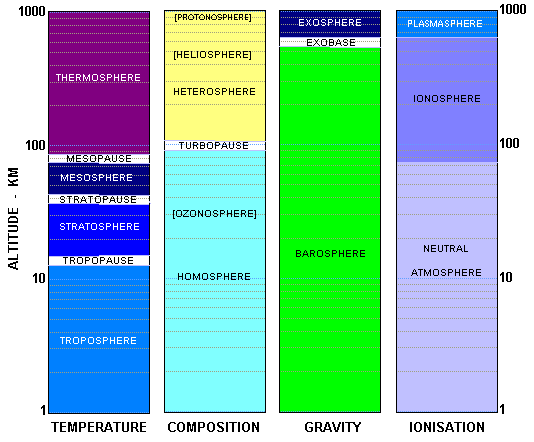
Various regions of the Earth's atmosphere are named according to a number of different classification schemes. Four classifications are illustrated in the diagram below. These are based respectively on temperature, compostion, gravitation and ionisation. Different regions are suffixed by -sphere whereas the division between regions is suffixed by -pause where the prefix is the region below or -base where the prefix is the region above.

In the temperature classification, the troposphere is where the surface weather occurs. Here the temperature decreases 2 degrees Kelvin (or Celsius) for every 300 metres altitude increase. In the stratosphere the temperature increases slightly, whereas in the mesosphere (or middle atmosphere) it decreases again. The mesosphere is the coldest part of the atmosphere at around 180 K. The temperature rises rapidly in the thermosphere to over 1000 K.
In composition the atmosphere is fairly uiniformly mixed up to about 100 km in the homosphere. Above this the individual gases are separated (the heterosphere) and the composition is no longer 80% nitrogen and 20% oxygen. The heterosphere, as with other regions, can be subdivided according to the predominant gaseous species.
Below about 600 km gravity manages to overcome the thermal motion of the molelcules, and most of the gas is retained by the Earth. Above this altitude, in the exosphere, moecules have enough energy to exceed the Earth's escape velocity of 11 km/sec.
The atmosphere starts to become ionised above about 70 km. Maximum ion concentration occurs in the ionospheric F2 layer at about 300 km. Above about 700 km the Earth's magnetic field starts to strongly control motions of the ionised plasma and this is termed the plasmasphere. This extends to at least 10 Earth radii, until it loses control to the plasma of the solar wind, blowing outwards from the Sun. This extended area of terrestrial magnetic control is also referred to as the magnetosphere, but this is strictly not an ionisation classification.
 Australian Space Academy
Australian Space Academy